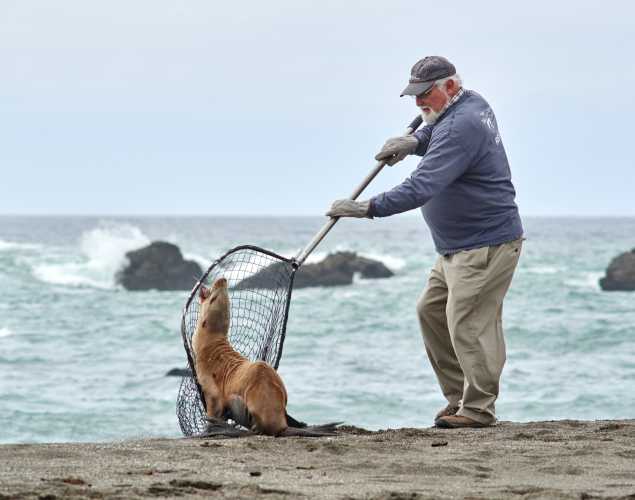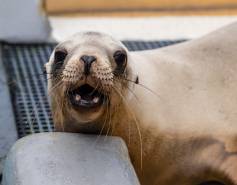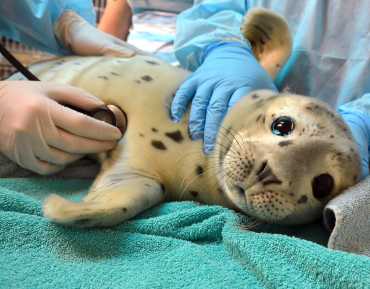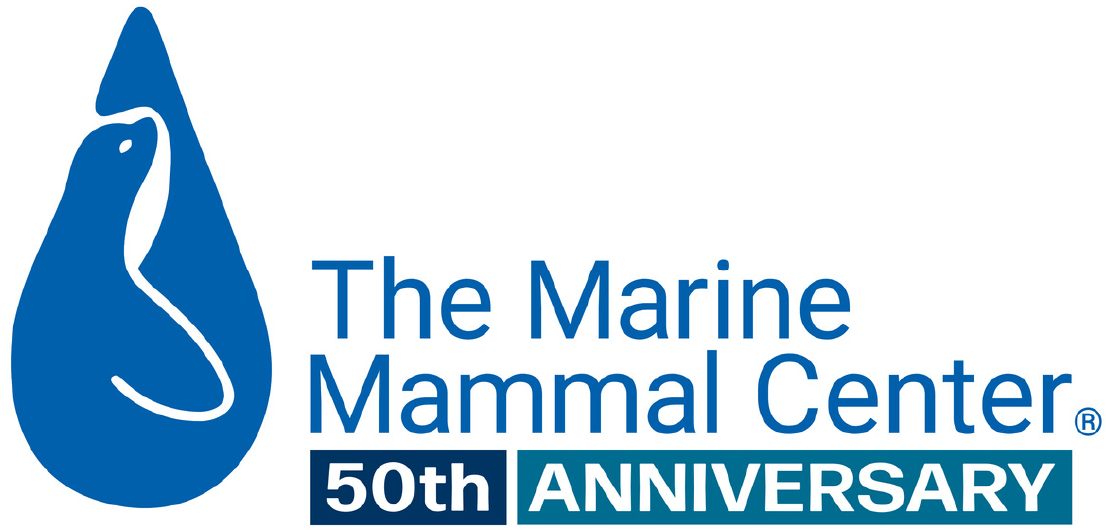
Why Do We Rescue?
- Cancer
- Domoic acid
- Malnutrition
- Species conservation
- Climate change
As the California sea lion crisis continues, The Marine Mammal Center is committed to responding to every individual animal. But our reasons for rescuing these animals are about so much more than just the individual.
From its very beginning, The Marine Mammal Center has been an organization with animal welfare at its core. When our founding volunteers first began rescuing stranded sea lions, the effort was about easing suffering and lending a helping hand to animals in need.
This still rings true for us today—responding to suffering animals and providing them with life-saving care is the right and humane thing to do. But the reason we do this work is so much bigger than that now.
Compassion in a Crisis
Earlier this month, we rescued our 1,000th animal for the year, and have now rescued more than 1,100. That means that in the first four months of this year, we have taken in more patients than we did during the entirety of 2014, and we are on pace to break every record set in our 40 years.
In the midst of a crisis like this, where does that compassion end? Why continue rescuing after the 100th, 500th, 1,000th seal or sea lion?
Because as much as this work is about giving each individual animal the care and attention it needs to return to the wild with a second chance, it is also about populations as a whole, the health of the ocean and even human health.
Research Insights
The Marine Mammal Center’s experts are leading contributors to global knowledge about marine mammal health, including developing innovative medical techniques and conducting vital research that has revealed alarming ocean health concerns.
{"image":"\/Animals\/Patients\/California sea lions\/2018\/cropped-images\/csl-pangea-by-bill-hunnewell-c-the-marine-mammal-center-122-86-2680-2093-1603244631.jpg","alt":"California sea lion with mouth open","label":"Research Library","title":"Cancer","link_url":"\/science-conservation\/research-library\/cancer","type":"page"}

{"image":"\/Animals\/Patients\/California sea lions\/2019\/cropped-images\/csl-pammysue-by-bill-hunnewell-c-the-marine-mammal-center-405-0-2354-1838-1603243352.jpg","alt":"California sea lion Pammysue","label":"Research Library","title":"Domoic Acid Toxicosis","link_url":"\/science-conservation\/research-library\/domoic-acid-toxicosis","type":"page"}

Connections to Human Health
One sick sea lion won’t tell you much about the health of the greater population. But thousands of sick sea lions rescued over the course of four decades have taught us a lot. In fact, scientists at The Marine Mammal Center have discovered entirely new diagnoses with relevance to human health issues.
In 1998, our senior scientist, Dr. Frances Gulland, discovered that California sea lions are susceptible to a toxin called domoic acid that is produced by a type of algae. Domoic acid targets a specific part of the brain called the hippocampus, which is responsible for spatial processing and memory.
Sea lions affected by domoic acid toxicity often have seizures in addition to exhibiting other abnormal behavior. Scientists at the Center have collaborated on research showing that the brain lesions caused by domoic acid are nearly identical to those seen in temporal lobe epilepsy in humans, translating to a greater understanding of that disease.
Domoic acid can also affect humans who eat contaminated shellfish, resulting in a life-threatening condition called amnesiac shellfish poisoning. Because sea lions are often the first to be affected by a toxic algal bloom, we alert the public health department when we see an outbreak, which helps them better target their surveillance to protect human health.
Domoic acid toxicity isn’t the only illness both humans and marine mammals share. In a typical year, more than 17 percent of sea lions admitted to The Marine Mammal Center are suffering from cancer.
Remarkably, nearly every case is the same type: urogenital carcinoma. Similar to cervical cancer in humans, it starts in the cervix but by the time the patients reach our hospital, the cancer has usually spread through the body.
Cancer research built on our findings in sea lions has revealed some important links. Just as cervical cancer is related to a papillomavirus infection, the sea lions’ urogenital carcinoma seems to be related to a herpesvirus infection.
Researchers have also found a genetic link—animals with cancer have been found to be more closely related genetically than animals without cancer.
Tissue samples from sea lions with cancer have also been associated with higher levels of chemicals like PCB than sea lions without cancer. This organic pollutant is stored in the blubber, or fat layer, of marine mammals and builds up over time, much like it does in humans.
While there is more to be learned about the complex factors that play into the development of this disease, what we learn from these animals contributes to research that could eventually lead to cures for humans.
Learn More About Our Conservation Programs
The Center is committed to being an advocate and champion for ocean health—a voice for the patients it cares for—and to inspiring a sea of change to protect the ocean’s future.
{"image":"\/Animals\/Wild\/Other species\/whale-with-oil-rig-shutterstock.jpg","alt":"whale feeding with oil rig in background","label":"Conservation","title":"Climate Change","link_url":"\/science-conservation\/conservation\/climate-change","type":"page"}

{"image":"\/Animals\/Wild\/Hawaiian monk seal\/hawaiian-monk-seal-in-fishing-gear-shutterstock.jpg","alt":"Hawaiian monk seal tangled in fishing gear","label":"Conservation","title":"Ocean Trash","link_url":"\/science-conservation\/conservation\/ocean-trash","type":"page"}

{"image":"\/Animals\/Patients\/Harbor seals\/2018\/hs-woody-by-bill-hunnewell-c-the-marine-mammal-center.jpg","alt":"harbor seal pup with a fish in its mouth","label":"Conservation","title":"Sustainable Seafood","link_url":"\/science-conservation\/conservation\/sustainable-seafood","type":"page"}

{"image":"\/Animals\/Wild\/Humpback whale\/cropped-images\/humpback-whale-photo-c-allison-payne-0-855-3826-1764-1625873951.jpg","alt":"humpback whale breaching in front of San Francisco","label":"Conservation","title":"Cetacean Conservation","link_url":"\/science-conservation\/conservation\/cetacean-conservation","type":"page"}

{"image":"\/Animals\/Wild\/Hawaiian monk seal\/cropped-images\/HMS-wild-NOAA-4-832-3197-1474-1603733454.jpg","alt":"Two Hawaiian monk seals sleeping on the beach.","label":"Conservation","title":"Hawaiian Monk Seal Conservation","link_url":"\/science-conservation\/conservation\/hawaiian-monk-seal-conservation","type":"page"}

Sounding the Alarm
As we care for and diagnose these animals, we’re not just learning about the specific diseases that affect marine mammals, we’re also learning about the health of the ocean as a whole.
Animals like California sea lions serve as sentinels of the sea, alerting us to the dangers they face. Rescuing these animals can help raise the alarm and inspire public action on threats like pollutants, ocean trash, overfishing and global warming.
Because many of the threats marine mammals face are caused by human impacts, we feel an even greater responsibility to rescue, rehabilitate and return these animals to the wild.
The Marine Mammal Center is committed to going beyond rescue and research to provide education programming that also helps bring these issues to light. While the cute faces of our patients may draw in the visitors, our educators ensure they’ll leave with more awareness about the overall health of our ocean and what they can do to help.
We care about each animal that comes into our care, and we mourn the loss of those that we can’t save. But in every interaction with every patient, we’re providing compassion and care and advancing our collective ability to make a difference in profound ways.
Yes, I want to save a life!

Yes, I want to save a life!
You’ll be giving sick and injured animals the best possible care at the Center’s state-of-the-art hospital. With your gift today, you are giving a patient a second chance at life in the wild.
See Our Latest News
{"image":"\/Animals\/Wild\/Gray whale\/cropped-images\/2025-03-30-gray-whale-BlackSandsBeach-c-the-marine-mammal-center-206-0-1270-992-1743546220.jpg","alt":"stranded gray whale","title":"Experts respond to a dead gray whale in the Marin Headlands as sightings of the species increase in San Francisco","link_url":"https:\/\/www.marinemammalcenter.org\/news\/experts-respond-to-a-dead-gray-whale-in-the-marin-headlands-as-sightings-of-the-species-increase-in-san-francisco","label":"Press Release","date":"2025-04-01 02:00:00"}

Experts respond to a dead gray whale in the Marin Headlands as sightings of the species increase in San Francisco
April 1, 2025
Read More{"image":"\/Animals\/Wild\/Humpback whale\/cropped-images\/humpback-whale-sea-lions-photo-c-bill-hunnewell-102-0-1270-992-1743014972.jpg","alt":"A California sea lion jumps out of the ocean next to a humpback whale showing its tail and another whale showing its back.","title":"What is the Loudest Animal on Earth? And Other Animal Trivia","link_url":"https:\/\/www.marinemammalcenter.org\/news\/what-is-the-loudest-animal-on-earth-and-other-animal-trivia","label":"News Update","date":"2025-03-26 07:00:00"}

{"image":"\/Animals\/Patients\/California sea lions\/2024\/csl-autumn-photo-by-chris-deimler-c-the-marine-mammal-center.jpg","alt":"A California sea lion with a small satellite tag on its back walks on a rocky beach toward the ocean.","title":"From Treating Sick Sea Lions to Tracking Them in the Wild: Follow Autumn","link_url":"https:\/\/www.marinemammalcenter.org\/news\/from-treating-sick-sea-lions-to-tracking-them-in-the-wild-follow-autumn","label":"Patient Update","date":"2025-02-27 15:23:46"}

From Treating Sick Sea Lions to Tracking Them in the Wild: Follow Autumn
February 27, 2025
Read More{"image":"\/Animals\/Patients\/California sea lions\/2024\/cropped-images\/csl-pinger-entanglement-photo-by-bill-hunnewell-c-the-marine-mammal-center-119-0-1270-992-1740529371.jpg","alt":"An entangled California sea lion with a netting material around its neck. ","title":"What it Takes to Rescue an Entangled Sea Lion","link_url":"https:\/\/www.marinemammalcenter.org\/news\/what-it-takes-to-rescue-an-entangled-sea-lion","label":"News Update","date":"2025-02-27 02:00:00"}

domoic acid
malnutrition
species conservation
climate change
California Sea Lion
Hawaiian Monk Seal

